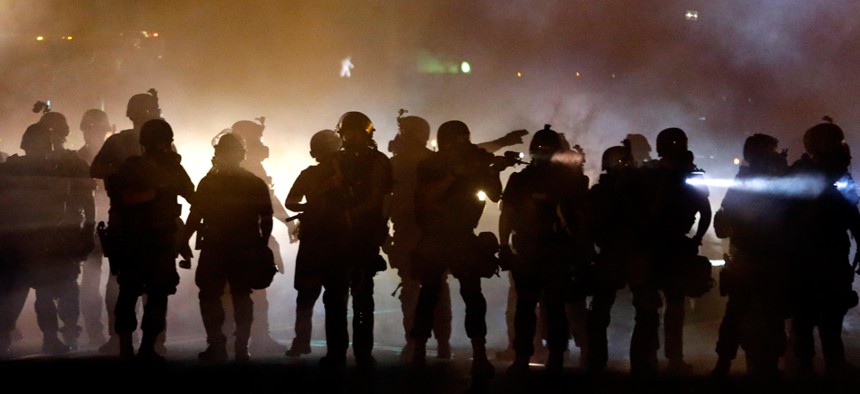How Congress Helped Create Ferguson’s Militarized Police

Police confront protestors Wednesday night. Jeff Roberson/AP

Connecting state and local government leaders
It all goes back to 1990.
Since 2006, the Pentagon has distributed 432 mine-resistant armored vehicles to local police departments. It has also doled out more than 400 other armored vehicles, 500 aircraft, and 93,000 machine guns.
As The New York Times reported in June, the Defense Department has been making use of unused military equipment by giving it to local precincts.
This is despite the fact that violent crime in the U.S. has steadily plummeted since 1993. Between 1993 and 2012, the violent-crime rate dropped by nearly 50 percent.
Yet today, local police—in cities and small towns across the country—are increasingly loaded for bear. How did this militarization of the police force come about? It all seems to have started with an obscure section in a defense bill passed more than 20 years ago.
In 1990, Congress passed a National Defense Authorization Act with a clause allowing the "transfer of excess personal property" from the Defense Department to local law enforcement—otherwise known as Section 1208. The clause was included in response to the surge of violent crime and the War on Drugs in the late 1980s. (It's worth noting that at the time, both chambers of Congress were controlled by Democrats.)
Here's the full language of the Section 1208:
SEC 1208. TRANSFER OF EXCESS PERSONAL PROPERTY
(a) TRANSFER AUTHORIZED.—
(1) Notwithstanding any other provision of law and subject to subsection (b), the Secretary of Defense may transfer to Federal and State agencies personal property of the Department of Defense, including small arms and ammunition, that the Secretary determines is—
(A) suitable for use by such agencies in counter-drug activities; and
(B) excess to the needs of the Department of Defense.
(2) Personal property transferred under this section may be transferred without cost to the recipient agency.
(3) The Secretary shall carry out this section in consultation with the Attorney General and the Director of National Drug Control Policy.
(b) CONDITIONS FOR TRANSFER.—The Secretary may transfer personal property under this section only if—
(1) the property is drawn from existing stocks of the Department of Defense; and
(2) the transfer is made without the expenditure of any funds available to the Department of Defense for the procurement of defense equipment.
(c) APPLICATION.—The authority of the Secretary to transfer personal property under this section shall expire on September 30, 1992.
The transfer program does not foist armored vehicles upon local precincts—as The Timesexplains, "the pace of transfers depends on how much unneeded equipment the military has, and how much the police request." And for local police departments with tight budgets, the free gear can be a welcome windfall. But it can also mean a disproportionately armored police force in a town of, say, 21,000.
The Pentagon's transfer program may have been a direct outgrowth of the War on Drugs, but as Alec MacGillis wrote in The New Republic on Thursday, it's not the only cause of heightened police militarization. The terrorist attacks of 9/11 led to a heightened state of security in the U.S., and that has trickled down to local law enforcement.
On a national level, the current Congress may be expected to reverse the actions of 1990. On Thursday, Sen. Rand Paul wrote a column in Time chastising the use of excessive force in Ferguson. "There is a legitimate role for the police to keep the peace, but there should be a difference between a police response and a military response," he wrote. "The images and scenes we continue to see in Ferguson resemble war more than traditional police action."
Paul's colleagues across the aisle share that concern. "This is America, not a war zone," Sen. Elizabeth Warren tweeted on Thursday. "The people of #Ferguson just want answers. We all want answers."
"Together, we should all mourn the loss of life in Ferguson, Missouri and work to keep our communities safe and free," Sen. Ted Cruz wrote in a Facebook post. "Police officers risk their lives every day to keep us safe, and any time a young man loses his life in a confrontation with law enforcement, it is tragic."
We still don't know all the details of what happened Sunday night between a Ferguson police officer and 18-year-old Michael Brown. What we do know is that the police response has made the safety of its own forces a No. 1 priority.
Back in June, a Missouri police captain told The Times that civilians should be fine with police militarization, so long as it means their public servants are being kept safe. "When you explain that you're preparing for something that may never happen, they get it," the captain, Tiger Parsons, said at the time.
But as tear-gas canisters and rubber bullets rain down on Ferguson's residents, they may be less than understanding about the excess of caution the police are using to protect their own.
Stephanie Stamm contributed to this article.
NEXT STORY: Another City Declares a Water Emergency






